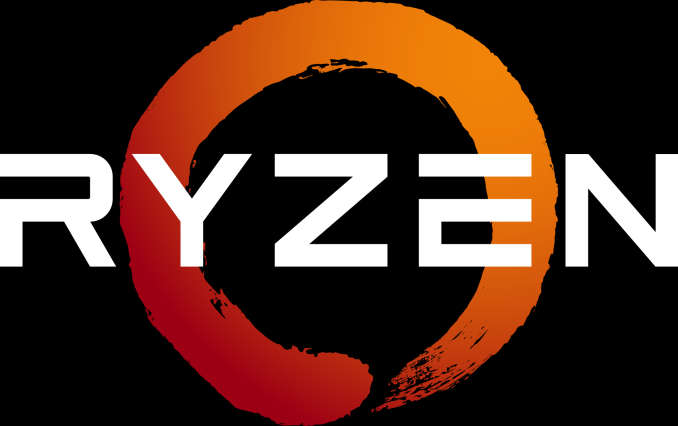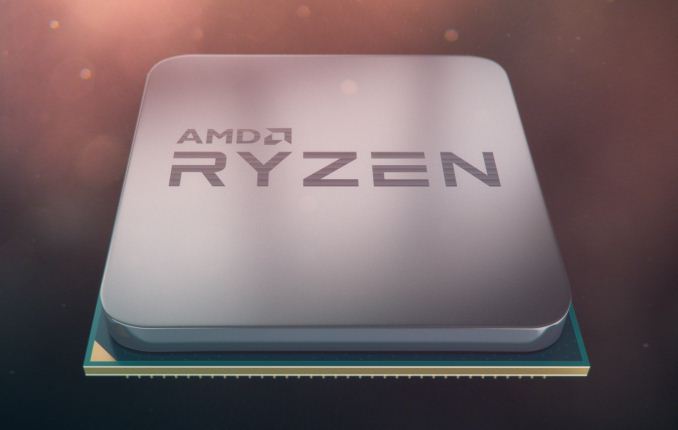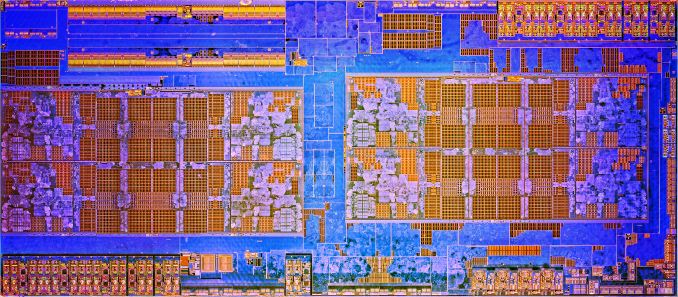AMD Launches Ryzen: 52% More IPC, Eight Cores for Under $330, Pre-order Today, On Sale March 2nd
by Ian Cutress on February 22, 2017 9:00 AM EST
The biggest x86 launch for AMD in five years is today: Ryzen is here. As always before a major launch, AMD gives a ‘Tech Day’ for relevant press and analysts, and through this event AMD’s CEO, Dr. Lisa Su lifted the lid on one of the most anticipated products in the semiconductor industry. AMD knows how to control the level of enthusiasm for its fans, and today is the end result, with processors going on pre-order from major retailers today at 1pm EST, ready for a general hard launch on March 2nd.
In a similar vein to launches of recent smartphones, AMD is doing a staggered announcement/launch with the products on their new microarchitecture. Where Samsung/Apple might give all the details for a product a few weeks before it’s available to buy, today on February 22nd marks the day where AMD is giving consumers information about Ryzen, and specifically the Ryzen 7 family of eight-core products. All the information today is from AMD, and AMD’s internal testing, and pre-orders also start from today for users ready to put down their money for a launch day part. Reviews of the CPUs, as well as when the CPUs will ship to customers, is on March 2nd. This also happens to be right in the middle of two annual shows, Game Developer Conference (GDC) and Mobile World Congress (MWC), making the time between receiving pre-launch samples and being able to provide independent verification of AMD’s performance claims relatively frantic. We’ll do our best!
The Ryzen Family
With a new processor launch, naming the parts and positioning them within the market is critical. So with Ryzen, the processor stack will be split into three based on performance and price: Ryzen 7 at the high end, Ryzen 5 in the middle, and Ryzen 3 for more price-conscious consumers. Both Ryzen 5 and Ryzen 3 are set to be launched later, and Ryzen 7 is the first portion of the family to be released.
Ryzen 7 will have three CPUs to start, all having eight cores and supporting simultaneous multi-threading:
- Ryzen 7 1800X: 8C/16T, 3.6 GHz base, 4.0 GHz turbo, 95W, $499
- Ryzen 7 1700X: 8C/16T, 3.4 GHz base, 3.8 GHz turbo, 95W, $399
- Ryzen 7 1700: 8C/16T, 3.0 GHz base, 3.7 GHz turbo, $329
Ryzen 7 1800X will be the high-end part, featuring a base clock of 3.6 GHz and a turbo of 4.0 GHz, within a TDP of 95W, and for $499. Next to this is Ryzen 7 1700X, launching at $399, with a base/turbo of 3.4/3.8 GHz. The final part for the launch is the Ryzen 7 1700, providing eight cores and sixteen threads for $329 at 3.0/3.7 GHz frequencies.
Processors will initially be available for pre-order from 185 retailers and OEMs worldwide, either as individual parts or pre-built systems.
What, not 40% IPC? 52% IPC??
Enthusiasts and analysts use the term IPC, or ‘Instructions Per Clock’, as a measure of how much the underlying microarchitecture improves from generation to generation. Two decades ago, a good design on a smaller node could net a healthy double-digit gain, whereas in recent years 5-10% gain has become the norm. When AMD initially announced that the new Zen microarchitecture they were developing was aiming for a 40% IPC gain, despite the low IPC they were starting from, users remained skeptical. AMD rehired Jim Keller to work alongside long-term AMD architect Mike Clark and produce a team with several goals in mind: high-performance x86, simultaneous multithreading, and a product to be relevant in the computing, PC, server and mobile space again. So despite this, 40% IPC always seemed a somewhat lofty goal, because Bulldozer was so underwhelming, and despite this low starting point. For the Ryzen launch today, AMD is stating that the final result of that goal is a 52% gain in IPC.
This is something we will need to test in due course!
The Ryzen Silicon, and the Future
AMD pointed out that the new 8-core silicon design runs 4.8 billion transistors and features 200m of wiring. Through previous announcements we’ve examined parts of the microarchitecture including cache sizes, threading, front-end/back-end design, and so on.
AMD Zen Microarchiture Part 2: Extracting Instruction-Level Parallelism
AMD Gives More Zen Details: Ryzen, 3.4 GHz+, NVMe, Neural Net Prediction, & 25 MHz Boost Steps
AMD’s CEO was keen to point out that this is a from-scratch design for AMD, using the knowledge gained from features developed for previous products but ultimately under the hood it looks like ‘a typical x86 high-performance core’, with AMD-specific features and tweaks. We were told that AMD’s roadmap extends into the multi-year range, so while the focus for 2017 will be on this family of products, back at HQ the next two generations are in various stages of development.
BENCHMARKS PLEASE
So despite the 82+ motherboards going to be available, 19 initial PC system builders moving into 200+ through the first half of 2017, the big question on everyone’s lips is how exactly does it perform?
Well, AMD gave us the following numbers:
AMD's benchmarks showed that the top Ryzen 7 1800X, compared to the 8-core Intel Core i7-6900K, both at out-of-the-box frequencies, gives an identical score on the single threaded test and a +9% in the multi-threaded test. AMD put this down to the way their multi-threading works over the Intel design. Also, the fact that the 1800X is half of the price of the i7-6900K.
In a similar vein, again with the Cinebench 15 multi-threaded test, the Ryzen 7 1700X scores over and above the Core i7-6800K (its price competition) and higher than the Core i7-6900K which costs 2.5 times as much.
We’ll tell you what our benchmarks say, with official retail processors. But you will have to wait until March 2nd. Sorry.





















386 Comments
View All Comments
redraider89 - Monday, February 27, 2017 - link
All that talk about how seemingly unrealistic getting a 40% increase in IPC is pretty ridiculous as if it isn't already being done. One, if they were trying to get 40% more from Piledriver or Bulldozer, then sure. But we are not, so that's one reason it's ridiculous.Two, isn't Intel's CPUs already about 40% better than the FX CPUs? And the Phenom's IPC is better than the FX CPUs. So it's already being done. It's ridiculous to say that AMD hasn't had a CPU that's better than the FX, when they have and ridiculus to basically say that ONLY Intel can develop a CPU with higher IPC than the Piledriver and Bulldozer CPUs have.
Outlander_04 - Monday, February 27, 2017 - link
No, phenom was not better IPC than the X3XX cpu's . It was relatively close though at the expense of a bigger die and higher power consumptionfourier07 - Monday, February 27, 2017 - link
This release remembers me when the Athlon 64 was the king until the Conroe arrived. It has been about 10 years with Intel as the king. But in this long interval Intel has speculated with its prices just for 15-20% of performance, and in the time being maybe less. Now AMD release a CPU able to compete vs the 6900k for $500! So that I think the times of "fat cows" for Intel is over, at less in the next few years.nos024 - Monday, February 27, 2017 - link
So...tell me what is the advantage of buying an 1800x over a 1700? $200 difference, if you factor in the cost of the cpu cooler? A total ripoff. *yawns* if you are going to price a cpu at $500, at least give it 40 pcie3 lanes?Outlander_04 - Monday, February 27, 2017 - link
And if the heat spreader on the 95 watt chips is more heavily built with better thermal paste?pencea - Tuesday, February 28, 2017 - link
Hopefully when your reviews comes, there won't be any bias or influence from Intel.Intel Allegedly Playing Dirty To Undercut AMD’s Ryzen
The editors-in-chief of two of America’s top PC hardware and technology publications have confirmed to Wccftech that they have indeed been approached by Intel regarding upcoming Ryzen reviews. Although both said that it was business as usual. Affirming that Intel’s response following AMD’s Ryzen announcement was what they had expected it to be and nothing was particularly unusual about it.
wccftech.com/intel-playing-dirty-undercut-amd-ryzen/
Intel is rattled with AMD Ryzen. Its 10-year old Nehalem CPU architecture that has been shrunk and incrementally updated over the years, is finally coming across as dated in the wake of AMD's "Zen" architecture. What to do when a competitor with 1/50th your R&D budget threatens to wreck your next annual appraisal? Play dirty and arm-twist the media of course! And playing dirty Intel is, according to a TweakTown report.
Apparently, Intel has scrambled its PR department to call in favors with the press in return for "guidelines" on how to review AMD Ryzen. Intel's PR emails allegedly ask reviewers to "call us before you write." The guidelines are worded more to make it sound like Intel wants its chips to be reviewed "fairly" against Ryzen, but the underlying objective is clear.
Outlander_04 - Tuesday, February 28, 2017 - link
Yes, it looks like intel is quite happy to try its underhand anti-competitive tactics again .Yet another reason to buy Ryzen
GeoffreyA - Wednesday, March 1, 2017 - link
Intel feared the Athlon 64 and they now fear Ryzen.MongGrel - Thursday, March 9, 2017 - link
Intel never feared Athlon 64, they are not fearing anything now.
Cooe - Sunday, February 28, 2021 - link
All the blatantly illegal anti-competitive/anti-competition market manipulation & OEM bribing BS Intel pulled off in-between 1998 & 2008 says you have no freaking clue what the hell you are talking about... Athlon 64 (most ESPECIALLY the A64 Opterons) absolutely scared the freaking SHIT out of Intel!!! So much so they broke just about every anti-monopoly law you can think of trying to prevent its widespread adoption. Also, if they weren't scared of A64/A64x2, how in the HELL do you explain the absurd disaster that was the Pentium-D???